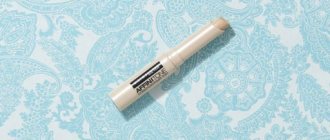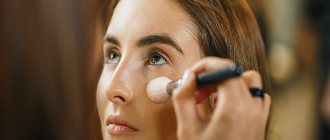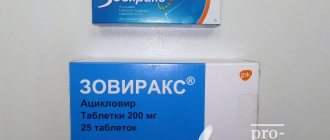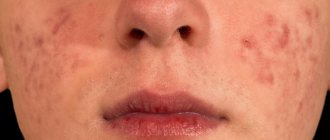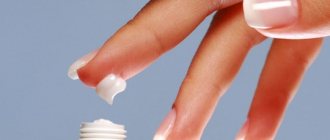Home » Face
Category: Face
Our skin serves as a kind of identifier of both external and internal problems, reflecting them through the appearance of various kinds of rashes, redness, as well as painful acne and pimples. Treating these types of problems can take quite a long time. In order to look good and not be embarrassed to go out with problem skin, you can use cosmetics after learning how to cover up acne with foundation.
- The essence of the problem
- Auxiliary materials
- Choosing the right product
- Facial skin preparation
- How to cover up acne with cosmetics
- Useful tips
The essence of the problem
There are quite a few reasons for skin rashes and acne - hormonal levels, the environment, and chlorinated water.
In addition, red bumps in the most visible place may be the result of poor nutrition or facial care (or maybe even the lack of it). Smoking and alcohol also have a detrimental effect on a person’s appearance, including the condition of the epidermis. All these factors do not cancel the desire to have a beautiful and healthy complexion and even skin tone. Knowing how to cover up acne on your face with foundation will help you regain your sense of self-confidence and disguise problem areas.
If signs of allergies or skin diseases appear on your face, you should definitely consult a dermatologist. Cosmetics are only a temporary and external disguise of the problem, and not its solution. The main thing is to start treating inflammation.
When is it better not to use foundation for acne?
The above algorithm for applying decorative cosmetics can only be used in exceptional cases. For daily makeup, you should use light-based cosmetics and choose a foundation that covers acne well. It is important to remember that women with a lot of rashes that do not go away for a long time should start acne treatment.
You should not use foundation in the following cases:
- allergic rash;
- weeping eczema or psoriasis on the face;
- rashes that have developed into cysts;
- contact dermatitis;
- herpes;
- individual intolerance to the components contained in the foundation.
If you apply thick makeup to your face every day, the epidermis will not be able to be saturated with oxygen and receive a sufficient amount of fluid from the environment. As a result, the pores will become clogged, and pathogenic bacteria will begin to multiply intensively, causing new acne to appear. Therefore, it is important to identify the cause of the rash and exclude the presence of serious diseases. It's worth visiting a dermatologist. To get rid of acne you will have to adjust your diet, change your cosmetics, walk more in the fresh air and exercise regularly.
Auxiliary materials
There are several ways to relieve inflammation. Here are some tools that will help with this:
- Visin eye drops. Soak a cotton swab in the medicine and put it in the freezer for 5-10 minutes. Then take it out and apply it to the pimple until it thaws. Small spots turn white immediately. A large pimple needs to be repeated several times until it helps.
- Tea tree essential oil is an excellent antiseptic and works well against age-related acne. All you need to do is apply it to the problem area. After 5-6 hours, the inflamed area will turn pale. For best results, this manipulation must be repeated regularly.
- Streptocide - the tablet must be crushed and mixed with water to a paste consistency. Apply it to the inflamed area and leave for a while.
- Ordinary toothpaste will help quickly reduce inflammation. It is applied for a few minutes and the redness disappears.
Choosing the right product
For sensitive problem skin, you need to choose special cosmetics marked “hypoallergenic” and only those that suit your skin type. The consistency of the foundation should be soft enough so that it covers imperfections on the face in an even layer and does not interfere with the access of oxygen to the pores.
Preference should be given to water-based products (oil free) containing mineral components, and also tea tree oil, salicylic acid, sulfur, zinc, vitamins A and B. Some ingredients act as absorbents, others regulate the functioning of the sebaceous glands .
Even when using high-quality medicinal cosmetics, do not forget to wash it off before going to bed!
What requires camouflage
Symptoms of rashes that require camouflage:
- redness;
- painful sensations;
- formation of a purulent head.
Red, inflamed and large white pimples are the first candidates for careful camouflage. Small pimples and blackheads are not so noticeable. Large and painful ones spoil the appearance and attract attention. In some cases, they can be hidden under hair. But, as luck would have it, they appear in the most visible place - on the cheeks, forehead, chin.
You can disguise pimples using decorative cosmetics. It will hide the redness, although it will not be able to smooth out the tubercle that appears. Also, if you have extra time, you can resort to home cosmetology recipes that help quickly relieve the inflammatory process. This will make it easier to disguise with foundation or correctors.
Facial skin preparation
Immediately before using foundation, you must carry out the following procedures:
- Cleansing. The cream will lie on the skin more evenly if it is thoroughly cleansed beforehand. Dirt and excess sebum must be removed. For problem skin, it is not advisable to use a scrub. It will damage the dermis and spread bacteria throughout the face. It is better to use foam or mousse for washing or wipe with tonic.
- Hydration. Every skin type needs hydration, so don't skip this step. For oily, problem or combination skin, special attention should be paid to the choice of moisturizer.
Contraindications
Even with the most harmless composition of cosmetics, there is a possibility of individual intolerance. Therefore, before you start using a concealer, it is recommended to check your skin for an allergic reaction.
The use of corrective agents for severe inflammation of the epidermis is also prohibited. In addition, there are skin infections, the presence of which prohibits the use of any cosmetic products. An open wound surface is a direct contraindication for corrective agents.
Cosmetologists warn that detection of a negative reaction of the body to a corrector becomes the reason for refusing to use it. In this case, you should consult a doctor and determine which component you are allergic to. This will help you make the right choice of corrector another time.
How to cover up acne with cosmetics
Hiding pimples is not an easy task, especially if they are quite large.
But nothing is impossible. For successful results, apply cosmetics in the following order:
- Concealer
A concealer with a healing effect must be applied pointwise to the inflamed areas and given 10-15 minutes so that it has time to dry. You should not smear the product around the pimple, as this can make the defect even more noticeable.
A green concealer will help minimize the red color of acne. Modern products not only hide imperfections, but also dry out problem areas of the skin. Some products contain bactericidal additives and have an antiseptic effect.
- Makeup base or primer
In addition, the primer is an excellent base for subsequent makeup: it will last much longer and the skin with the base will look smoother and more even.
Experts have developed products for problem skin. During the day, they help fight excess sebum and shine. There is also a line of moisturizing makeup bases.
- Concealer
Using different shades of foundation, you can create a perfectly even skin tone and smooth texture. To do this, the pimple is first masked with a dark tone, and then a general lighter tone is applied.
A good example of a foundation for acne-prone skin is Clinique's Redness Solutions Foundation. This is a medicinal cosmetic that helps with rashes and redness.
- Shimmering cream or powder
Such products contain tiny shiny particles that scatter light and thereby even out the skin color, giving it a healthy glow. They need to be selected to match your skin tone. Such cosmetics are not applied to the entire face, but according to the highlighter principle - on the cheekbones, chin, and a little on the forehead.
- And again concealer
Beige matte concealer. The ideal option is to have a dark and light shade. We draw a dark color around the tubercle, and cover the peak itself with a light color. Carefully erase the borders and shade thoroughly. On healthy skin, movements may be more intense. It is used in the same way as green - locally.
As a similar product, you can use Dermablend Corrective Foundation from Vichy.
- Powder
Using a gentle blotting motion, fix the concealer using powder and a sponge in the places where we just applied it. Then, using a brush, apply a small amount of powder evenly to the rest of the face.
This video will help you correctly apply makeup on a face with acne:
Which foundation conceals acne better?
Foundation with a pinkish tint can make acne on your face even more noticeable. Dark creams are perfect only for dark-skinned women. It is necessary to choose the color of cosmetics, taking into account your natural skin tone or a little lighter.
One of the best options for painful facial skin with large areas of rashes is a creamy mineral-based foundation. It contains special shimmering particles.
When using new cosmetics, it is important to test them for allergies. To do this, you need to apply a little product to your hand and observe the reaction throughout the day. If redness, itching and pimples are not noticed, then you can safely use this product. Otherwise, the condition of the facial skin can worsen and new rashes will not keep you waiting.
Useful tips
- It is advisable to touch the “problem” face as little as possible. This will keep you from spreading bacteria.
- Each time after use, the brush or sponge must be thoroughly cleaned to prevent the spread of bacteria during subsequent applications.
- Even in a hurry, we must not forget about preliminary care procedures before makeup! When time is short, you still need to thoroughly cleanse and moisturize your face. This is the basis of success.
- If you put a thick layer of makeup on a face with acne, the skin will stop breathing, and bacteria will begin to develop even faster, and the defect will look even more noticeable.
- To eliminate visible defects, use light natural tones. To cover acne, use creams that are thicker in texture, but those that do not provide shine.
- Try to carefully blend the edges of your makeup to achieve a natural and natural look.
- After achieving an even tone on your face, do not use pink blush. Newly camouflaged pimples may appear next to this color. Beige, coffee or peach blush is suitable.
- You should also avoid wearing red lipstick.
- In the image it is better to focus on the eyes. Makeup using the smokey eye technique is appropriate, which makes the eyes attractive and expressive and gives them the effect of a mesmerizing look.
Many people make the mistake of thinking that using a thick foundation will help hide all imperfections in one motion. Temporarily yes, but with long-term daily use they will only make your problems worse! Thick foundations are not intended for such frequent use! These products are an ideal solution for photography or an evening out, nothing more.
Correct and skillful use of cosmetics can not only hide facial defects, but also highlight its advantages. High-quality cosmetics that are suitable for your age and skin structure will help you achieve this. The main thing is not just to cover up pimples, but to start treating inflammation and taking proper care of your face.
